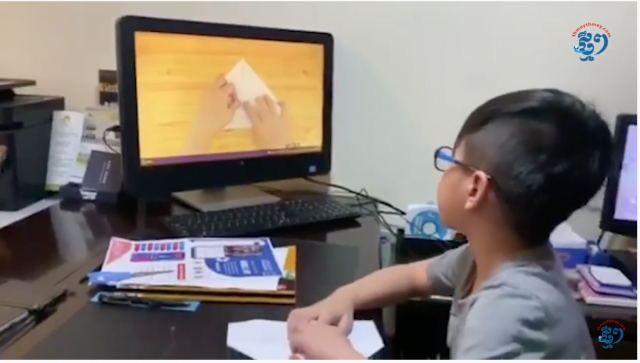Online learning during COVID-19: Key challenges and suggestions

- Kimkong Heng and Koemhong Sol
- December 13, 2020 9:50 AM
The COVID-19 pandemic has caused global disruption, affecting every aspect of human life in many ways. A telling example of the disruption caused by COVID-19 is the temporary closure of educational institutions worldwide.
As schools and universities were ordered to close to contain the spread of the coronavirus, traditional physical classes were transitioned to an online mode of learning. The transition was abrupt, posing a lot of challenges for students, teachers, school administrators, and even parents. In this article, we examine different variations or names for online learning, discuss key challenges, and offer suggestions to improve the effectiveness of online learning.
Variations of online learning
Several terminologies associated with online learning have been used. They include e-learning, online learning, distance learning, blended learning, and hybrid learning. Each of these terminologies alludes to the act of using technology in learning, but there are slight differences among them.
Online learning: It is often used interchangeably with e-learning, is a form of distance education that involves using technology as the mediator of the learning process, and that teaching is entirely delivered through the internet (Siemens et al., 2015). In online learning, students access learning materials, submit their works, receive feedback, and interact with peers online.
Distance learning/education: It has the same structure as online learning. It can be synchronous (happening at the same time) or asynchronous (self-paced) (Offir et al., 2008). Distance learning is defined as “teaching and planned learning where the teaching occurs in a different place from learning, requiring communication through technologies and special institutional organization.” (Siemens et al., 2015, p. 99). It is simply an effort to provide access to learning for those who are geographically distant (Moore et al., 2011).
Blended learning: It is also known as hybrid learning. It refers to the practices that combine (or blend) traditional face-to-face classroom instruction with online learning (Siemens et al., 2015). Compared with other forms of online learning, blended learning provides students with more fruitful channels of getting connected with their peers and instructors (Park & Shea, 2020). Academic research also suggests that blended learning gives students a better understanding of course content due to the support of social interactions (Garrison & Kanuka, 2004). The diagram below shows the difference between online learning and blended learning (Pearson, 2020).

Challenges associated with online learning
Even though online learning is not a novel phenomenon, the sudden transformation into online learning has posed substantial challenges for educational activities globally, particularly in Cambodia, where educational institutions, teachers, and students are generally not ready for this unexpected disruption. A recent study by Adedoyin and Soykan (2020) points out several concrete challenges caused by the abrupt digital transformation of instructional operations during the period of the COVID-19 pandemic. Key challenges are related to technological infrastructure and digital competence, socio-economic factors/inequality, assessment and supervision, heavy workload, and compatibility issues.
By its nature, online learning depends entirely on technological devices and the internet, so it is undeniable that technology is the most pressing challenge to online learning. Some typical technological issues include lack of knowledge of how to use applications, unstable/slow internet connection, outdated communication devices, and incompatible browsers. Jalli (2020) argues that the lack of internet access poses great challenges for students in Southeast Asia to study online.
In Cambodia, teachers and students, particularly in rural areas, do not have reliable internet access and are not capable of using emerging technology, making online learning a difficult, if not frustrating, experience for many (see Flynn & Himel, 2020). Despite the efforts by the Ministry of Education, Youth and Sport (MoEYS) to provide online learning opportunities by disseminating video lessons through television and other online platforms such as MoEYS Facebook page, YouTube channel, and e-learning website, the number of students who have had access to online learning is still low (UNESCO, 2020).
The sudden shift to online learning has also created an unexpected workload, particularly on building e-platforms and integrating external applications into their systems in a timely manner (Adedoyin & Soykan, 2020). The extra workload has caused stress and anxiety for teachers and administrators (MacIntyre et al., 2020; Winthrop, 2020).
There are many other challenges. For instance, online or distance learning amid the pandemic has created more stress, frustration, and isolation for students who have lost the opportunity for peer interactions (Daniel, 2020; Gillett-Swan, 2017). The unprecedented shift to online learning has also increased concerns regarding cybersecurity, cyberbullying, online violence and exploitation, and other psychological issues caused by difficulties and uncertainties associated with online learning during the COVID-19 pandemic (Daniel, 2020; Yan, 2020).
Suggestions to enhance the effectiveness of online learning
A number of researchers have put forward suggestions on how to enhance the effectiveness of online learning during the COVID-19 pandemic. Naffi and colleagues (Naffi et al., 2020) suggest eight ways universities can improve equity and access to online learning. They include (1) create accessible materials; (2) choose adequate digital technologies; (3) record lectures and caption videos and audio content; (4) adopt inclusive culturally responsive teaching; (5) adopt a flexible approach to student participation; (6) ensure financial support and equipment; (7) understand student needs; and (8) address systemic racism.
Leif et al. (2020) argue that online learning can be made more accessible and inclusive through five simple steps, such as (1) consider how students will navigate through your online classroom; (2) provide a video tour of your online classroom at the start of the semester; (3) ensure all Word documents, PowerPoint presentations, and PDF files are accessible and searchable; (4) add alternative text (alt text) to images and graphics so that they can be read aloud when students use a screen reader; and (5) add captions and transcriptions to video lessons. Some of these suggestions may not be applicable to the Cambodian contexts, yet they are worth considering where appropriate.
Martin (2020) offers a five-point guide for educators to optimize online learning in the time of COVID-19. The five key considerations include instruction (explicit, orderly, and well-organised); content (high-quality and appropriate to students’ level); motivation (self-regulation, parents’ involvement, and tasks that separate students from online environment); relationships (interpersonal relationships through various communication channels and sufficient face-to-face online instructions); and mental health (reaching out to students who may need help and informing them about who to contact when they need mental health support).
Meanwhile, Dhawan (2020) discusses several solutions to problems associated with online education. The solutions may include pre-recording video lessons or lectures; humanizing the learning process by making it more interesting, dynamic, and interactive; creating forums for communication using social media and other digital platforms; continuously improving the quality of the online courses; allowing students to ask questions and provide feedback; and promoting collaborative learning, project-based learning, and group-based learning.
To create an engaging online learning environment, Fung et al. (2020) recommend strengthening student-teacher interaction and utilizing it to enhance online learning. They suggest that teachers should start class early and use the chart function to conduct regular checkpoints to check up on students. Asking students to turn on their videos can also increase their attention to the lectures or class activities. Another tip to keep students engaged is to regularly seek their real-time responses during online classes. To do this, teachers can use interactive platforms such as Poll Everywhere, Mentimer, Kahoot!, Padlet and Pigeonhole Live.
Specific to the Cambodian context, Sun (2020) suggests that MoEYS and local education departments should cooperate with school principals and community chiefs to provide personalized support, such as home visits by classroom teachers, to students who cannot access online video lessons disseminated by MoEYS through television channels, Facebook, YouTube, and Telegram. Heng (2020) calls for “innovative policy interventions and increased investment” to support the integration of ICT in the classroom, especially in remote areas where technological infrastructure is scant.
Leng et al. (2020) offer six-point recommendations to ensure the successful switch to online learning and teaching in Cambodia. They include (1) supportive institutional leadership; (2) development of digital infrastructure and literacy; (3) pedagogy-enhancing training opportunities; (4) technical and social support for students, teachers, and staff; (5) change in attitudes toward learning and teaching; and (6) increased government support.
Conclusion and recommendations
In conclusion, the COVID-19 pandemic has made online learning a new normal in most, if not all, educational contexts across the globe. While online learning during COVID-19 has obviously brought about the many challenges for concerned education stakeholders, COVID-19 has appeared to be a silver lining in the crisis. It provides a strong impetus for the digital transformation of education across different levels.
There are various suggestions advanced by researchers to address the problems associated with online learning. Some of the above-mentioned solutions centre around five key factors, including instruction, content, motivation, relationships, and mental health (see Martin, 2020). Other key solutions are to do with preparation, lesson delivery, course quality, communication, student-teacher interaction, and student engagement (Dhawan, 2020; Fung et al., 2020). The role of leadership, investment, government support, and attitudes towards learning and teaching are also vital for the success of online learning and teaching during the pandemic (Leng et al., 2020).
To ensure online learning and blended learning are widely adopted in the post-pandemic time in developing societies such as Cambodia, more government support and investment are needed. Educational institutions also need to invest in developing and improving existing online learning platforms as well as expanding the provision of internet access and online library resources. Training and orientation programs about online learning, including lessons on online teaching and learning tools and strategies, need to be offered on a regular basis so that students, teachers, and staff could have the opportunity to advance their knowledge and understanding of the different aspects and nuances of online and blended learning.
Kimkong Heng is currently an Australia Awards scholar pursuing a PhD in Education at the University of Queensland in Brisbane, Australia. He is a co-founder and co-editor of Cambodian Education Forum.
Koemhong Sol is currently a Japanese Government (MEXT) scholar pursuing a PhD in Education at the International Christian University in Tokyo, Japan. He is an associate editor of Cambodian Education Forum.
A longer version of this article was published by Cambodian Education Forum on December 08, 2020.















